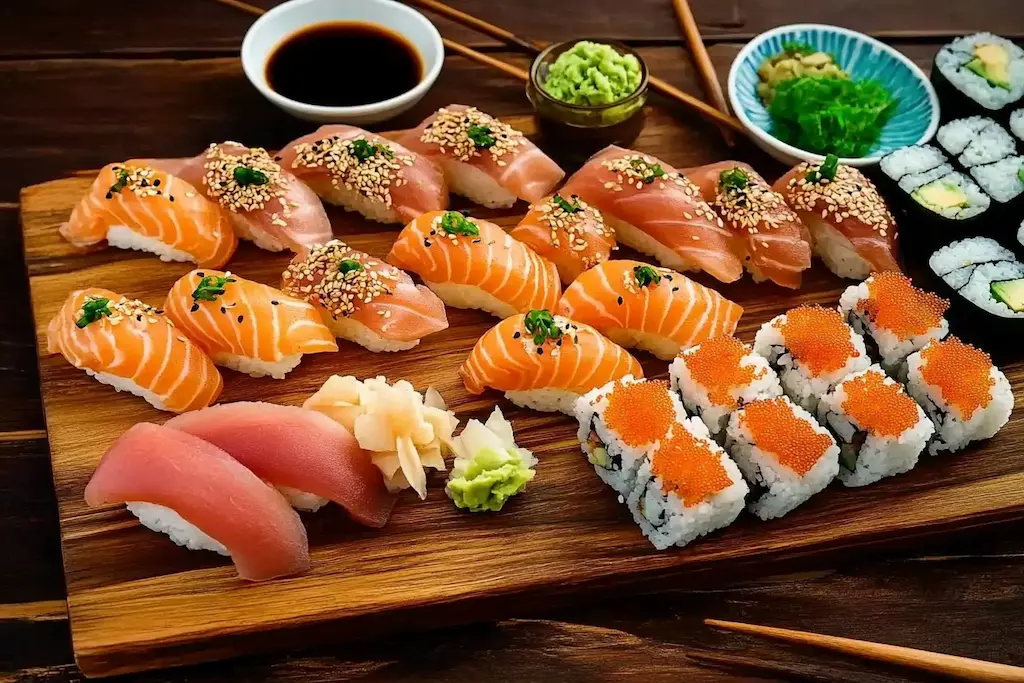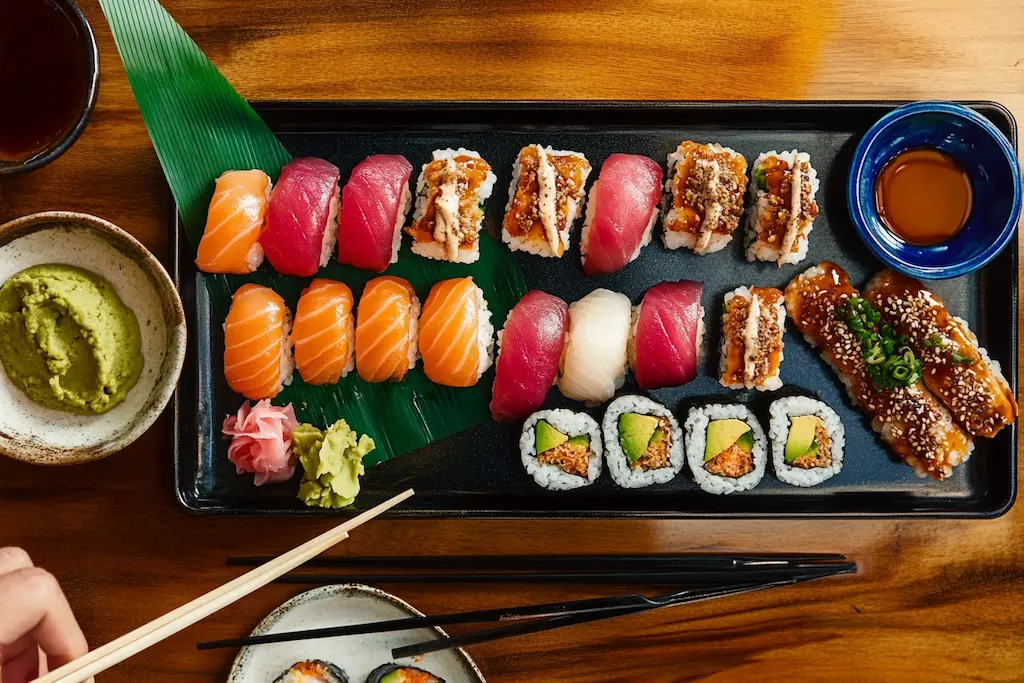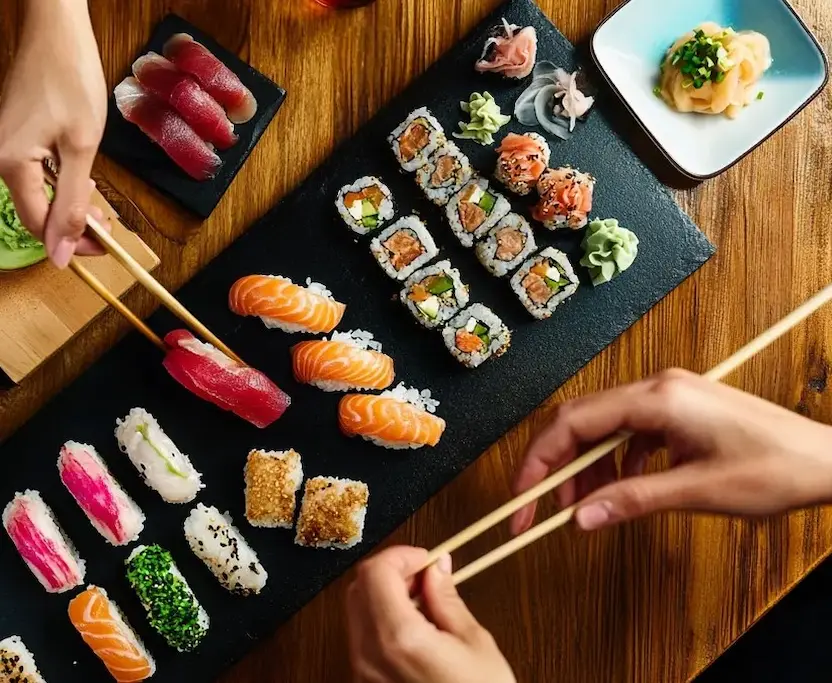Sushi is one of those foods that can feel like a never-ending love affair. From its delicate presentation to the burst of flavors in every bite, it’s no wonder sushi is a global favorite. But let’s face it—ordering the right amount can be tricky. How many sushi rolls per person are enough to satisfy hunger without overloading your plate? Let’s explore this in detail, so you never have to second-guess your sushi portions again.
How Many Sushi Rolls Per Person: Key Factors to Consider
Picture this: you’re at a sushi restaurant or planning a sushi night at home. You’re staring at the menu, unsure whether three rolls will suffice or if you should add that fourth. We’ve all been there.
The truth is, sushi portions are not a one-size-fits-all situation. There are plenty of factors at play—your appetite, the occasion, the type of sushi, and even cultural norms. Let’s break it down so you can order confidently next time.

Recommended Sushi Rolls Per Person for Every Occasion
Deciding how many sushi rolls per person to serve isn’t just a numbers game—it’s a balancing act. Here are the key factors you’ll want to consider:
Sushi Rolls Per Person: Appetite and Preferences
Are you the kind of person who could eat sushi all day, or do you fill up quickly after a few bites? Appetite varies greatly from person to person. Some people savor each piece slowly, while others pop sushi rolls like popcorn.
Think about the guests or people you’re serving. If you’re dining with sushi enthusiasts, they might eat 8–10 rolls without breaking a sweat. For light eaters, 4–6 rolls might do the trick.
Pro Tip: “Start small. You can always order more sushi if needed—most places prepare it fresh and fast!”
Planning Sushi Rolls Per Person for Snacks vs. Full Meals
Are you planning sushi as the star of the show or just one part of the meal? If it’s a full dinner, you’ll need more rolls. But if sushi is just an appetizer or paired with other dishes like soup, salad, or tempura, you can aim for fewer rolls per person.
For example:
- Appetizer portion: 2–3 rolls per person.
- Main course: 6–8 rolls per person.
Types of Sushi and Their Impact on Portions
Not all sushi is created equal. Rolls (makizushi) are typically more filling than nigiri or sashimi. Rolls often include rice, seaweed, and a variety of ingredients like fish, vegetables, and sauces, making them more substantial.
In contrast, sashimi (thinly sliced fish) and nigiri (a slice of fish on top of rice) are lighter options, so you may need more pieces to feel satisfied.
How Many Sushi Rolls Per Person for Every Occasion
When you’re hosting a sushi night, the vibe matters! A casual meal at home might lean towards a generous portion because everyone feels more comfortable indulging. On the other hand, formal events may have smaller, measured portions for a touch of elegance.
💡 Fun Fact: In Japan, sushi portions are traditionally smaller, focusing on quality and presentation rather than quantity.
Recommended Sushi Rolls Per Person
Now that we’ve covered the basics, let’s get to the golden question: how many sushi rolls should you actually order?
Guidelines for Adults
For adults with an average appetite, 6–8 sushi rolls usually hit the sweet spot for a full meal. That translates to about 36–48 individual pieces (since each roll typically has 6 pieces). If you’re dining with sushi lovers, feel free to bump it up to 8–10 rolls per person.
Recommendations for Children
Kids and sushi are an adorable combo, but let’s be real—they probably won’t eat as much. Depending on age and appetite, 2–4 rolls are generally plenty for children.
Keep the sushi simple for kids:
- Cucumber rolls (kappamaki)
- Avocado rolls
- California rolls (minus the wasabi, of course!)
Adjustments for Special Diets (Vegetarian, Gluten-Free, etc.)
Dietary restrictions don’t have to complicate sushi night. Many sushi rolls can be customized for vegetarians, vegans, or those with gluten sensitivities. However, specialty rolls often have smaller portions due to limited ingredients.
For vegetarians or gluten-free eaters, 5–7 rolls might be the perfect amount since these options tend to be lighter.
“Sushi is about finding the balance between what satisfies your taste buds and your hunger. Don’t be afraid to ask your sushi chef for guidance if you’re unsure!”
How to Estimate Sushi Rolls for a Group
Whether you’re hosting a small get-together or planning a larger event, estimating sushi portions can feel overwhelming. Here’s how to keep it simple:
Calculating for Small Gatherings
For groups of 2–4 people, aim for 6–8 rolls per person. It’s always better to have a little extra sushi rather than risk running out.
Example calculation:
- 4 people x 8 rolls each = 32 rolls total.
Planning for Large Events or Parties
When catering for larger groups, variety is your best friend. Offer a mix of rolls, nigiri, and sashimi to cater to different tastes. Start with 4–6 rolls per person and adjust based on your crowd.
Example for a party of 20:
- 20 people x 5 rolls each = 100 rolls.
Adding Buffer Quantities to Avoid Shortages
It’s a good idea to add an extra 10–15% to your order. Why? Because sushi tends to disappear quickly when it’s good, and it’s better to have leftovers than to leave guests hungry.
💡 Quick Tip: Always double-check if anyone in your group has dietary restrictions or allergies. That way, you can order accordingly.

Common Problems When Ordering Sushi Rolls
Even with the best intentions and calculations, things can go awry when ordering sushi. From ordering too much to running out mid-meal, here’s how to avoid the most common pitfalls.
Ordering Too Much Sushi
We’ve all been there—you order a bit more “just in case,” and suddenly, the table looks like a sushi buffet. While leftovers are tempting, sushi doesn’t keep well. The rice hardens, and the fish loses freshness, making it less appetizing later.
If you’ve ever found yourself overwhelmed with sushi leftovers, you’re not alone. The key to avoiding this is to plan ahead. Instead of ordering in bulk, go for smaller initial orders, especially at restaurants that offer quick service.
Running Out of Sushi Mid-Meal
Equally stressful is the opposite problem: running out of sushi before everyone is satisfied. Nobody wants to see the last roll vanish while their hunger lingers.
This often happens at group gatherings when everyone underestimates their appetite or forgets to account for the sushi fans who go back for seconds.
Solution? Build a buffer into your sushi calculations. Ordering 10–15% extra ensures there’s enough to go around without overloading on leftovers.
Balancing Different Sushi Preferences in a Group
Sushi lovers can be picky. One person might crave tuna sashimi, while another can’t get enough of shrimp tempura rolls. Catering to varied preferences can feel like a juggling act, especially when dietary restrictions come into play.
To strike the right balance, offer a variety of sushi types. Include rolls with cooked ingredients for those who avoid raw fish, vegetarian rolls for plant-based eaters, and classic favorites like California rolls to satisfy a crowd.
“Think of your sushi order as a playlist: mix the hits everyone loves with a few adventurous tracks for variety!”
Solutions for Common Sushi Portion Issues
Whether you’ve ordered too much, too little, or mismatched preferences, there’s always a way to turn it around. Here’s how to handle those sushi-related dilemmas:
Managing Leftover Sushi Rolls Safely
If you’ve overestimated, it’s essential to store leftovers properly. Place sushi rolls in an airtight container and refrigerate them immediately. However, sushi is best eaten fresh, so try to consume leftovers within 24 hours.
For rice-heavy rolls, rehydrate the rice slightly before eating by microwaving for 10 seconds with a damp paper towel on top. But remember, sashimi and raw fish don’t reheat well and can lose their quality.
Preventing Waste by Ordering Strategically
To avoid waste, order sushi in waves. Start with a moderate portion and see how everyone feels before placing additional orders. Many sushi restaurants encourage this approach, as it ensures fresh preparation and allows you to adjust quantities as needed.
Using Sushi Rolls as Part of a Balanced Meal
Sometimes the problem isn’t with sushi itself but how it’s served. Pair sushi with complementary dishes like miso soup, seaweed salad, or edamame. This creates a balanced meal and prevents anyone from feeling like they didn’t get enough.
Sushi Rolls Per Person: Cultural Insights
Understanding the cultural context behind sushi portions can provide clarity on what’s “normal” and how much to serve.
Traditional Japanese Practices on Portion Sizes
In Japan, sushi is considered an art form. Portions are smaller, with an emphasis on quality over quantity. A single nigiri or sashimi piece might be served with great care, paired with soup or other sides to complete the meal.
Here, it’s less about eating until you’re stuffed and more about savoring each bite. It’s common to order a few pieces at a time rather than large rolls, making every piece intentional and fresh.
Western Variations in Sushi Portions
Western interpretations of sushi often take a more generous approach. Rolls tend to be larger, stuffed with additional ingredients like cream cheese, sauces, and fried elements. Because of this, people might find Western-style sushi more filling than traditional Japanese sushi.
These cultural differences are worth keeping in mind when deciding how much sushi to order, especially if you’re serving a mix of traditionalists and adventurous eaters.
Tips for Ordering the Perfect Amount of Sushi
Now that we’ve covered the basics and common challenges, let’s talk about actionable tips to help you nail the perfect sushi order every time.
Consulting with Sushi Chefs or Restaurants
Your sushi chef is your best ally when it comes to portion planning. Don’t be afraid to ask for recommendations—they’ve seen it all and can provide insights based on group size, appetite, and preferences.
Pro Tip: “Chefs often know which rolls are heavier or lighter, helping you create the right balance for your meal.”
Understanding Portion Descriptions on Menus
Sushi menus can sometimes feel like deciphering a code. Is it a single roll or a set of rolls? How many pieces does it include? Clarify with the server if needed to avoid surprises when your order arrives.
Combining Rolls with Other Dishes (Soup, Salad, etc.)
Sushi doesn’t have to stand alone. Adding side dishes not only enhances the meal but also helps manage portions. Think of these sides as sushi’s supporting cast—they make the main act even better!
Great pairing ideas include:
- Miso soup for a comforting start.
- Seaweed or cucumber salad for a refreshing side.
- Gyoza or tempura for something crunchy.
“Sushi is more than just a meal—it’s an experience. With the right planning, you can create a feast that satisfies both the stomach and the soul!”
Conclusion: Finding Your Perfect Sushi Portion
Sushi is more than just food—it’s an experience that brings people together, whether you’re dining at a cozy sushi bar, hosting a sushi night at home, or celebrating a special event. While the golden rule for sushi rolls per person typically hovers around 6–8 rolls for adults and 4–6 for lighter eaters or kids, the real magic lies in tailoring your order to fit the situation.
By understanding factors like appetite, meal type, sushi preferences, and group dynamics, you can confidently plan the perfect sushi feast every time. Whether you’re indulging in traditional Japanese nigiri or enjoying Western-inspired sushi rolls loaded with creative ingredients, the key is balance: enough to satisfy, but not so much that leftovers go to waste.

So next time you’re puzzling over a sushi menu or preparing to order for a group, just remember these tips. Start with the basics, factor in some buffer rolls, and don’t be afraid to mix things up with sides and variety. Sushi is all about delighting your taste buds, so make the most of it!
FAQs About How Many Sushi Rolls Per Person
Let’s wrap things up with answers to some common questions about sushi portions.
How many sushi rolls should I order for two people?
For two people, 12–16 rolls are usually a good amount if sushi is the main course. This gives each person 6–8 rolls, depending on their appetite. If you’re pairing sushi with sides or other dishes, you could reduce this to 8–10 rolls total.
What’s the ideal sushi order for a party?
For parties, plan around 4–6 rolls per person. Make sure to include a mix of vegetarian, cooked, and raw options to cater to diverse tastes. Always add an extra 10–15% to your total order to ensure there’s enough for everyone.
How do I avoid wasting sushi?
To avoid waste, order in waves rather than all at once. Start with a moderate amount and see how your guests feel. Many sushi restaurants allow you to place additional orders as the meal progresses.
What can I do with leftover sushi?
While sushi is best enjoyed fresh, you can store leftovers in an airtight container and refrigerate them. Eat within 24 hours, and avoid reheating raw fish. To freshen up rice-based rolls, microwave them briefly with a damp paper towel.
How do I plan sushi portions for kids?
Kids usually eat 2–4 rolls, depending on their age and appetite. Keep their options simple, like cucumber rolls, avocado rolls, or shrimp tempura rolls, and avoid spicy sauces or wasabi.
What are the best sides to pair with sushi?
Great sides to complement sushi include miso soup, edamame, seaweed salad, tempura, and even pickled vegetables. These dishes add variety and can help make smaller sushi portions feel more filling.
“Sushi is like art on a plate—beautiful, satisfying, and best enjoyed with a little planning. Now go forth and roll into your next sushi experience with confidence!”
